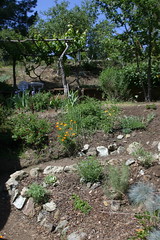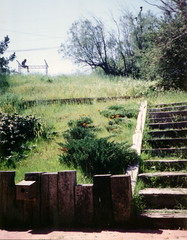The Wild Braid
Saturday, May 5th, 2007At the Sierra Club ExCom meeting in March, Cal began with a reading, as is our custom. It was from a new book by and about Stanley Kunitz, The Wild Braid, A Poet Reflects on a Century in the Garden.
The garden is a domestication of the wild, taking what can be random, and, to a degree, ordering it so that it is not merely a transference from thewild, but still retains the elements that make each plant shine in its natural habitat.
In the beginning, a garden holds infinite possibilities. What sense of its nature, or its kingdom, is it going to convey? It represents a selection, not only of whatever individual plants we consider to be beautiful, but also a synthesis that creates a new kind of beauty, that of a complex and multiple world. What you plant in your garden reflects your own sensibility, your concept of beauty, your sense of form. Every true garden is an imaginative construct, after all.
 I’m not sure if this is the actual passage he read, I was so struck both by the cover image of a bent-over hundred year old man gazing like a lover at his plants and by the recollection that Jan and I first set eyes on each other at a poetry seminar about Stanley Kunitz in 1966. Also distracted back then, I hadn’t paid attention to his writings since. But that book cover brought it together: the passage of time that we were planning to mark in our upcoming 40th anniversary celebration, not yet bent over, but transformed from children into grandparents. I mentioned the coincidence, there were appreciative murmurs, then on we went to discuss the budget.
I’m not sure if this is the actual passage he read, I was so struck both by the cover image of a bent-over hundred year old man gazing like a lover at his plants and by the recollection that Jan and I first set eyes on each other at a poetry seminar about Stanley Kunitz in 1966. Also distracted back then, I hadn’t paid attention to his writings since. But that book cover brought it together: the passage of time that we were planning to mark in our upcoming 40th anniversary celebration, not yet bent over, but transformed from children into grandparents. I mentioned the coincidence, there were appreciative murmurs, then on we went to discuss the budget.
While Jan made the guest list, mailed invitations, shopped for food, and spruced up the house, I prepared for the party by working in the garden, carving a new path in the adobe clay, trimming lower limbs of the pygmy oaks, transplanting bunch grasses. We were wedded in a garden in our backyard. Now this garden had turned into a setting I wanted to share for a while, just as I wanted to share the private space of marriage. When we arrived here nineteen years ago I knew this was a place I would transform and be transformed in. The change had come to pass.

The invitation to our celebration said “No gifts, but donations welcome to Santa Lucia Chapter of the Sierra Club or Environmental Center of San Luis Obispo (ECOSLO).” In the midst of the crowd at the drinks table, Cal handed me a package and said he was sorry to be violating the rule, but please would I open it. It was The Wild Braid.
Three days after the party I was missing classes, in bed with a sinus infection. Between naps, I wandered around in the book, finding poems about gardening and other outdoor experiences, memoirs about circumstances of their composition, prose reflections on their themes“bucolic retreat, cultivation, composting, decay, renewal, and the connections between horticulture and writing. They recalled my first scholarly article, “˜Fortunate Senex’: The Pastoral of Old Age.” Arranged like beds and terraces, I came upon photographs of the ancient sage among the trees and flowers and conversations that took place between him and Genine Lentine, his friend and caretaker during the time between partial recovery from a massive stroke and his death in 2004.
This morning I woke up at 5:15, still not healthy but eager to walk my trails at daybreak. Greeting the yucca, the hummingbird sage, the blue oak, seeing new blooms on the Columbine, I thought again of The Wild Braid. I’d only taken the first stroll through its garden. I’ll return to find paths I’ve missed and revisit familiar spots in changing seasons. Looking ahead, I knew I’d found a guide.
Post script–June 5
Last weekend, Jan made her pilgrimage to Tassajara, the Zen mountain retreat she’s visited every spring for the last 27 years. She was enrolled in a seminar which required her to bring along some poems. With my permission she took The Wild Braid. Upon her return she gave the book back and told me to look at the title page. On it was inscribed “For Jan and Steven–friends in the garden. With bright wishes, Genine.”

















